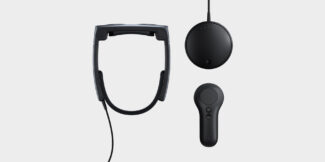Magic Leap 2 will be available for purchase to the general public in September starting at $3,299 with a 1-year “limited” warranty.
That’s the base price for the ultra-high end Magic Leap 2 AR headset with prices increasing from there for a “Developer Pro” edition that includes “access to developer tools, sample projects, enterprise-grade features and monthly early releases for development and test purposes, starts at MSRP $4,099 and includes a 1-year limited warranty”. There’s also the “Enterprise” edition starting at roughly $5K per headset “for environments that require flexible, large scale IT deployments and robust enterprise features. Includes quarterly software releases fully manageable via enterprise UEM/MDM solutions. Comes with 2 years of access to enterprise features and updates and will start at MSRP $4,999 and includes an extended 2-year limited warranty.”
We got our first good look at the specifications for Magic Leap 2 earlier this year and they suggested a best-in-class AR headset, with an included dynamic dimming feature that blocks outside light to make virtual objects more visible in a wider range of lighting conditions. Given recent restructuring in the division of Microsoft that delivered HoloLens 2 and reports suggesting that long-term efforts to build AR glasses at places like Meta are “yielding late and they’re yielding expensive,” we’re curious to see how far Magic Leap is able to take its technology in the next couple years. The first Magic Leap headset shipped in 2018 priced at roughly $2,300 with a design that put processing in a wired processing puck worn on your body, and Magic Leap 2 continues that design.

The official specifications as listed by the company for Magic Leap 2 claim “up to 70° diagonal FOV” with 120 Hz refresh rate. Here’s the full specs listed on Magic Leap’s site:
- Weight: 260g
- Camera: 12.6M pixel autofocus RGB camera, 4k at 30fps or 1920 x 1080 at 60fps video
- Memory/Storage: 256GB
- Volume of View: 37cm to infinity
- CPU: AMD 7nm Quad-core Zen2 X86 core (8 threads), 14 core CVIP engine, up to 3.92 GHz max with 512kB L2 per core, 4MB total L3 cache
- GPU: AMD GFX10.2: 1SE 1SA 4 WGP (8 CUs) 2RB+, 1MB L2 Cache 964 MHz / Max 1.8 GHz
- Display: 1440 x 1760px resolution, 20 to 2000 nits brightness
- Spatial Audio: Built-in Stereo Speakers
- Sensors: 3 Wider FoV World Cameras, Depth Camera, RGB Camera, Ambient Light Sensor, 4x Eye Tracking Cameras
- Inertial Sensors: 4x IMU, 3-axis Accelerometer and Gyroscope, 2x 3-axis Magnetometer, 2x Altimeter
- Battery: 3.5hrs continuous use, 7hrs sleep mode
- Security • WPA3AMD Platform Security Processor, TMR, Security fencing between x86 and CVIP
Magic Leap 2 will be available on September 30, 2022 with the company promising support for “OpenXR and WebXR coming in 2H 2022.”





